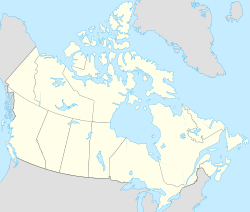Port Harrison
|
Inukjuak ᐃᓄᒃᔪᐊᒃ |
|
|---|---|
| Northern village municipality | |
 |
|
| Coordinates: 58°27′N 78°06′W / 58.45°N 78.1°WCoordinates: 58°27′N 78°06′W / 58.45°N 78.1°W | |
| Country |
|
| Province |
|
| Region | Nord-du-Québec |
| TE | Kativik |
| Constituted | 7 June 1980 |
| Government | |
| • Mayor | Siasi Iqrumia |
| • Federal riding | Abitibi—Baie-James—Nunavik—Eeyou |
| • Prov. riding | Ungava |
| Area | |
| • Total | 64.40 km2 (24.86 sq mi) |
| • Land | 55.63 km2 (21.48 sq mi) |
| Population (2011) | |
| • Total | 1,597 |
| • Density | 28.7/km2 (74/sq mi) |
| • Change (2006–11) | 0.0% |
| • Dwellings | 444 |
| Time zone | EST (UTC−5) |
| • Summer (DST) | EDT (UTC−4) |
| Postal code(s) | J0M 1M0 |
| Area code(s) | 819 |
| Website | www |
Inukjuak (Inuktitut: ᐃᓄᒃᔪᐊᒃ) (Inuktitut for The Giant) is a northern village (Inuit community) located on Hudson Bay at the mouth of the Innuksuak River in Nunavik, in the Nord-du-Québec region of northern Quebec, Canada. Its population is 1,597 as of the Canada 2011 Census. An older spelling is Inoucdjouac; its former name was Port Harrison.
It is not accessible by road, but by boat in summer and year-round by air through Inukjuak Airport.
The police services for Inukjuak are provided by the Kativik Regional Police Force, which has one police station in the village.
"The Giant" is the literal translation of the word Inukjuak, but originally it was Inurjuat, which means "many people". In the past there was an Inuk (singular for the word Inuit) who went down to the river of Inukjuak to fetch some water. While there, the person saw many Inuit in kayaks approaching from the mouth of the river, and then yelled back out to the community "Inurjuat! Inurjuat!". That is where the name for the community comes from.
The many archeological sites near Inukjuak indicate that the area has long been inhabited by Inuit.
At the beginning of the 20th century, the Révillon Frères company set up a fur trading post in Inukjuak, originally called Port Harrison. In order to compete with them, the Hudson's Bay Company (HBC) established a post in 1920. In the same year Révillon Frères paid for Robert J. Flaherty to film Nanook of the North (released 1922) in the area.
...
Wikipedia


